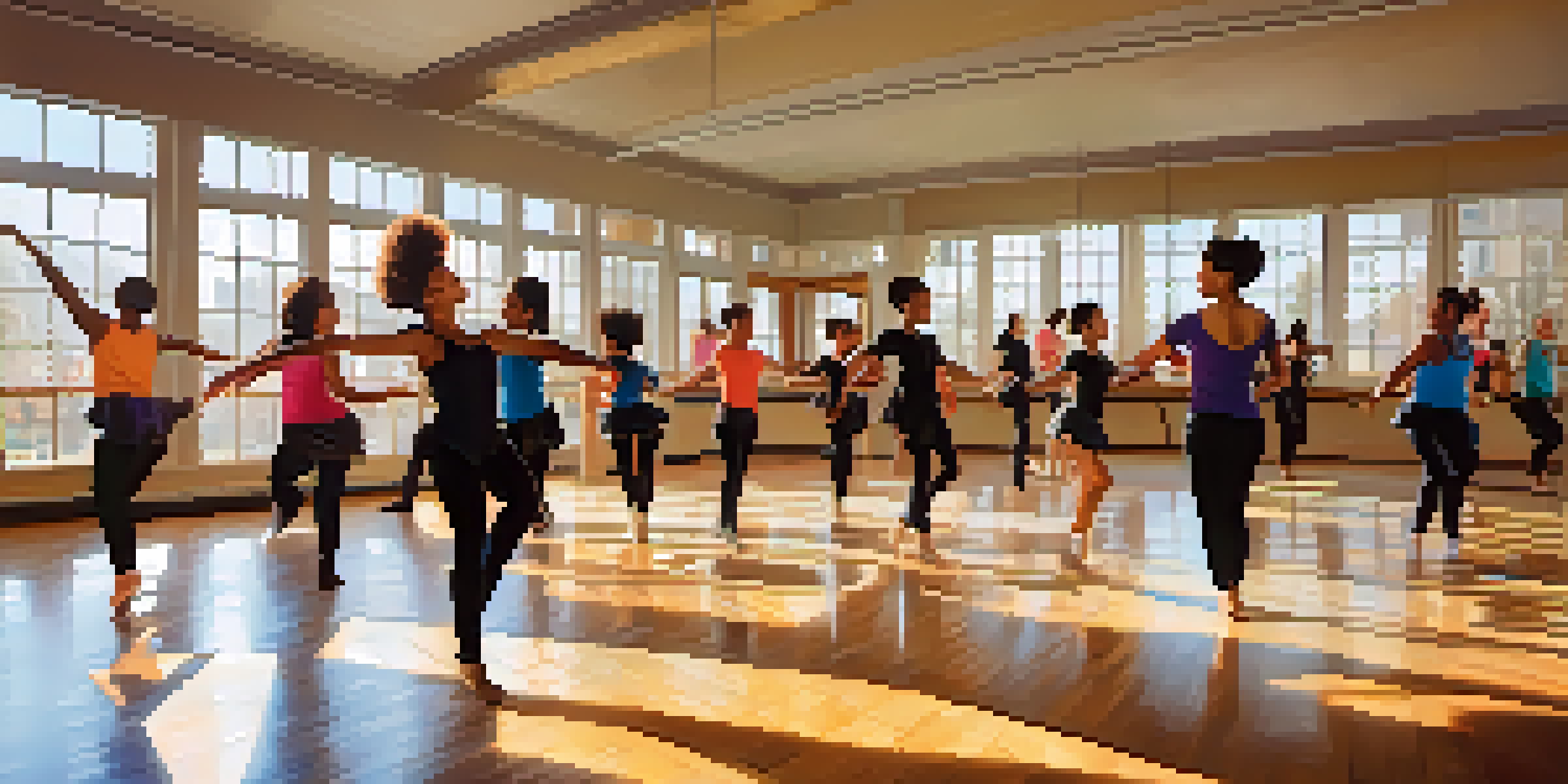The Intersection of Dance, Body Awareness, and Mental Health

Understanding Body Awareness Through Dance
Body awareness refers to the conscious perception of our body's position, movement, and sensations. Dance, as an expressive art form, plays a significant role in cultivating this awareness. When we dance, we become more attuned to our muscles, joints, and overall physical presence, fostering a deeper connection with ourselves.
Dance is the hidden language of the soul.
This connection allows dancers to move with intention, enhancing their coordination and balance. For instance, a ballet dancer must be aware of their posture to execute a perfect pirouette. This meticulous attention to their body not only improves performance but also builds confidence and self-esteem.
Furthermore, developing body awareness through dance can translate into everyday life. Individuals who dance often report feeling more in control of their movements, leading to improved physical health and reduced risk of injury. Ultimately, dance serves as a powerful tool for enhancing body awareness in a fun and engaging way.
The Therapeutic Benefits of Dance for Mental Health
Dance therapy is a growing field that uses movement to support mental health treatment. Engaging in dance allows individuals to express emotions that might be difficult to articulate verbally. For many, the rhythm and flow of dance provide a safe space to release pent-up emotions, reduce anxiety, and combat depression.

Moreover, various studies have shown that participating in dance can lead to increased levels of endorphins—the body's natural feel-good chemicals. When you dance, you not only get the physical benefits but also experience a natural mood boost. Imagine the joy of a group dance class where laughter and camaraderie are as essential as the steps themselves.
Dance Enhances Body Awareness
Engaging in dance cultivates a deeper connection with our body, improving coordination and confidence.
Additionally, dance fosters social connections, which are crucial for mental well-being. Whether it's a class, a community event, or simply dancing at home, these interactions can help combat feelings of loneliness and isolation. The shared experience of dance creates a sense of belonging, reminding us we are not alone in our struggles.
Dance as a Mindfulness Practice
Mindfulness involves being fully present in the moment, a state that dance inherently encourages. When we dance, we focus on our movements, the music, and our breathing, creating a meditative experience. This connection to the present can help quiet the noise of daily stressors and anxieties.
The body says what words cannot.
For example, consider how a simple dance class can transport you away from life's worries. As you immerse yourself in the rhythm, your mind finds peace, allowing for a moment of clarity amid chaos. This practice can be particularly beneficial for those struggling with racing thoughts or overwhelming emotions.
Moreover, the repetitive nature of certain dance styles, such as contemporary or ballet, enhances this mindful experience. Each step, turn, and leap becomes a form of meditation, helping to ground us in our bodies. By embracing this mindfulness, dancers can gain better control over their mental states, leading to improved emotional regulation.
Exploring Different Dance Styles for Mental Wellness
Different dance styles offer unique benefits for mental health and body awareness. For instance, styles like hip-hop and jazz can energize participants, providing an outlet for self-expression and creativity. The upbeat tempo of these genres often encourages participants to let loose, which can be liberating for the mind.
On the other hand, styles like yoga dance or contemporary emphasize slower movements and breath control, fostering relaxation and introspection. These practices not only enhance body awareness but also promote a tranquil state of mind, making them ideal for those seeking stress relief.
Dance Therapy Boosts Mental Health
Participating in dance allows for emotional expression and social connections, significantly reducing anxiety and depression.
Ultimately, exploring a variety of dance styles can help individuals find what resonates with them. Whether it's the high energy of salsa or the fluidity of modern dance, each style offers a chance to connect with oneself and others, highlighting the diverse pathways to mental wellness through movement.
Dance Communities and Their Supportive Role
Joining a dance community can significantly enhance the mental health benefits of dance. These communities provide a supportive environment where individuals can share their passion for movement and connect with others. From dance classes to local performances, these spaces foster friendships and create a sense of belonging.
For many, being part of a dance group can alleviate feelings of isolation. The shared experience of learning choreography or performing together nurtures a bond that transcends individual struggles. This collective spirit can uplift participants, reminding them that they are part of something bigger.
Additionally, dance communities often champion inclusivity, making them welcoming spaces for individuals of all backgrounds and abilities. This environment can empower participants to express themselves freely, embracing their unique styles and stories while promoting mental well-being through connection and creativity.
The Science Behind Dance and Mental Health
Research continues to uncover the profound connection between dance and mental health. Studies have shown that participating in dance can lead to reduced symptoms of anxiety and depression, while also enhancing cognitive function. This scientific backing reinforces the idea that dance is not just an art form but a vital contributor to holistic well-being.
For instance, a study published in the Journal of Health Psychology found that individuals who engaged in regular dance classes reported higher levels of life satisfaction and happiness. The communal aspect of dance, combined with the physical activity, creates a unique blend of benefits that positively impacts mental health.
Mindfulness Through Dance Practice
Dancing encourages mindfulness by keeping us present, which can help alleviate stress and improve emotional regulation.
Moreover, the brain's neuroplasticity—the ability to reorganize itself by forming new neural connections—is positively influenced by dance. This means that through dance, individuals can improve their mental resilience and adaptability. The more we dance, the more we support our brain's ability to cope with stress and change.
Incorporating Dance into Daily Life for Better Health
Incorporating dance into daily routines can be an enjoyable and effective way to boost mental health. Whether it's a spontaneous dance party at home or a regular class, finding time to move can uplift your mood and enhance body awareness. The key is to make it fun and accessible, allowing you to enjoy the process.
Consider setting aside just 10-15 minutes a day to dance. You could follow an online class, dance to your favorite songs, or even try out a new style. The goal is to find joy in movement without the pressure of perfection. This simple act can serve as a powerful tool for managing stress and improving overall well-being.

Additionally, inviting friends or family to join in can deepen the experience. Sharing the joy of dance not only strengthens relationships but also creates lasting memories. Ultimately, by weaving dance into the fabric of our daily lives, we open the door to enhanced mental health and a greater appreciation for our bodies.